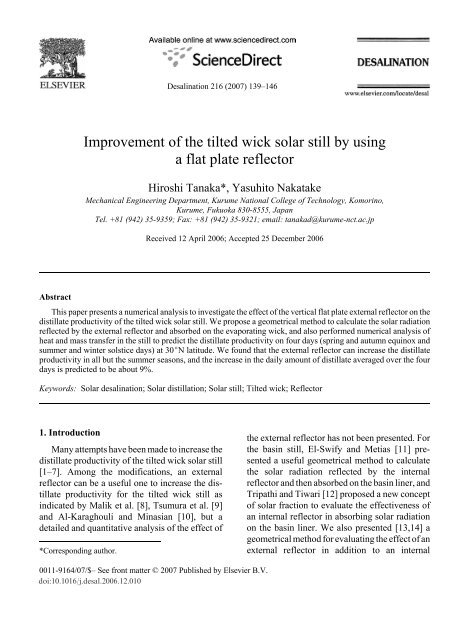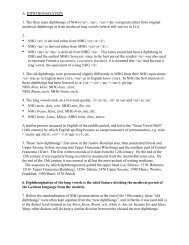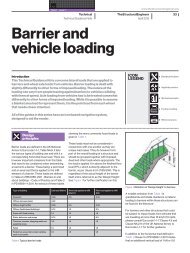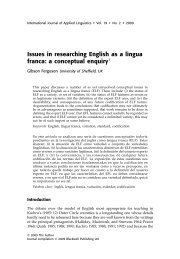Improvement of the tilted wick solar still by using a flat plate reflector
Improvement of the tilted wick solar still by using a flat plate reflector
Improvement of the tilted wick solar still by using a flat plate reflector
Create successful ePaper yourself
Turn your PDF publications into a flip-book with our unique Google optimized e-Paper software.
Abstract<br />
Desalination 216 (2007) 139–146<br />
<strong>Improvement</strong> <strong>of</strong> <strong>the</strong> <strong>tilted</strong> <strong>wick</strong> <strong>solar</strong> <strong>still</strong> <strong>by</strong> <strong>using</strong><br />
a <strong>flat</strong> <strong>plate</strong> <strong>reflector</strong><br />
Hiroshi Tanaka*, Yasuhito Nakatake<br />
Mechanical Engineering Department, Kurume National College <strong>of</strong> Technology, Komorino,<br />
Kurume, Fukuoka 830-8555, Japan<br />
Tel. +81 (942) 35-9359; Fax: +81 (942) 35-9321; email: tanakad@kurume-nct.ac.jp<br />
Received 12 April 2006; Accepted 25 December 2006<br />
This paper presents a numerical analysis to investigate <strong>the</strong> effect <strong>of</strong> <strong>the</strong> vertical <strong>flat</strong> <strong>plate</strong> external <strong>reflector</strong> on <strong>the</strong><br />
di<strong>still</strong>ate productivity <strong>of</strong> <strong>the</strong> <strong>tilted</strong> <strong>wick</strong> <strong>solar</strong> <strong>still</strong>. We propose a geometrical method to calculate <strong>the</strong> <strong>solar</strong> radiation<br />
reflected <strong>by</strong> <strong>the</strong> external <strong>reflector</strong> and absorbed on <strong>the</strong> evaporating <strong>wick</strong>, and also performed numerical analysis <strong>of</strong><br />
heat and mass transfer in <strong>the</strong> <strong>still</strong> to predict <strong>the</strong> di<strong>still</strong>ate productivity on four days (spring and autumn equinox and<br />
summer and winter solstice days) at 30EN latitude. We found that <strong>the</strong> external <strong>reflector</strong> can increase <strong>the</strong> di<strong>still</strong>ate<br />
productivity in all but <strong>the</strong> summer seasons, and <strong>the</strong> increase in <strong>the</strong> daily amount <strong>of</strong> di<strong>still</strong>ate averaged over <strong>the</strong> four<br />
days is predicted to be about 9%.<br />
Keywords: Solar desalination; Solar di<strong>still</strong>ation; Solar <strong>still</strong>; Tilted <strong>wick</strong>; Reflector<br />
1. Introduction<br />
Many attempts have been made to increase <strong>the</strong><br />
di<strong>still</strong>ate productivity <strong>of</strong> <strong>the</strong> <strong>tilted</strong> <strong>wick</strong> <strong>solar</strong> <strong>still</strong><br />
[1–7]. Among <strong>the</strong> modifications, an external<br />
<strong>reflector</strong> can be a useful one to increase <strong>the</strong> di<strong>still</strong>ate<br />
productivity for <strong>the</strong> <strong>tilted</strong> <strong>wick</strong> <strong>still</strong> as<br />
indicated <strong>by</strong> Malik et al. [8], Tsumura et al. [9]<br />
and Al-Karaghouli and Minasian [10], but a<br />
detailed and quantitative analysis <strong>of</strong> <strong>the</strong> effect <strong>of</strong><br />
*Corresponding author.<br />
0011-9164/07/$– See front matter © 2007 Published <strong>by</strong> Elsevier B.V.<br />
doi:10.1016/j.desal.2006.12.010<br />
<strong>the</strong> external <strong>reflector</strong> has not been presented. For<br />
<strong>the</strong> basin <strong>still</strong>, El-Swify and Metias [11] presented<br />
a useful geometrical method to calculate<br />
<strong>the</strong> <strong>solar</strong> radiation reflected <strong>by</strong> <strong>the</strong> internal<br />
<strong>reflector</strong> and <strong>the</strong>n absorbed on <strong>the</strong> basin liner, and<br />
Tripathi and Tiwari [12] proposed a new concept<br />
<strong>of</strong> <strong>solar</strong> fraction to evaluate <strong>the</strong> effectiveness <strong>of</strong><br />
an internal <strong>reflector</strong> in absorbing <strong>solar</strong> radiation<br />
on <strong>the</strong> basin liner. We also presented [13,14] a<br />
geometrical method for evaluating <strong>the</strong> effect <strong>of</strong> an<br />
external <strong>reflector</strong> in addition to an internal
140<br />
<strong>reflector</strong> on <strong>the</strong> <strong>solar</strong> radiation absorbed on <strong>the</strong><br />
basin liner <strong>of</strong> <strong>the</strong> basin <strong>still</strong>.<br />
Fur<strong>the</strong>rmore, we proposed a newly designed<br />
<strong>solar</strong> <strong>still</strong> [15], which consists <strong>of</strong> a vertical<br />
multiple-effect diffusion <strong>still</strong> and a <strong>flat</strong> <strong>plate</strong><br />
<strong>reflector</strong>, and we presented a geometrical method<br />
for calculating <strong>the</strong> direct and diffuse <strong>solar</strong> radiation<br />
directly absorbed on <strong>the</strong> vertical surface as<br />
well as <strong>the</strong> radiation reflected <strong>by</strong> <strong>the</strong> <strong>flat</strong> <strong>plate</strong><br />
<strong>reflector</strong> and absorbed on <strong>the</strong> vertical surface. We<br />
performed outdoor experiments [16] under <strong>solar</strong><br />
isolation in Kurume (33EN latitude), Japan, to<br />
validate <strong>the</strong> geometrical method, and <strong>the</strong> results<br />
show that direct, diffuse and reflected radiation<br />
absorbed on <strong>the</strong> vertical surface can be adequately<br />
calculated with <strong>the</strong> geometrical method<br />
we presented.<br />
The geometrical method for calculating <strong>the</strong><br />
effect <strong>of</strong> external <strong>reflector</strong> for <strong>the</strong> basin <strong>still</strong> as<br />
well as <strong>the</strong> vertical <strong>still</strong> can be easily modified to<br />
<strong>the</strong> <strong>tilted</strong> <strong>wick</strong> <strong>still</strong>. Therefore, in this paper, <strong>the</strong><br />
objective <strong>of</strong> <strong>the</strong> study is to <strong>the</strong>oretically find <strong>the</strong><br />
effect <strong>of</strong> <strong>the</strong> vertical <strong>flat</strong> <strong>plate</strong> external <strong>reflector</strong><br />
on <strong>the</strong> amount <strong>of</strong> <strong>solar</strong> radiation absorbed on <strong>the</strong><br />
evaporating <strong>wick</strong> as well as <strong>the</strong> di<strong>still</strong>ate productivity<br />
<strong>of</strong> a single slope <strong>tilted</strong> <strong>wick</strong> <strong>still</strong> at 30EN<br />
latitude. Finally, we give <strong>the</strong> optimum inclination<br />
<strong>of</strong> <strong>the</strong> <strong>tilted</strong> <strong>wick</strong> <strong>still</strong> with and without an external<br />
<strong>reflector</strong>.<br />
2. Solar radiation absorbed on <strong>the</strong> evaporating<br />
<strong>wick</strong> <strong>of</strong> a single slope <strong>tilted</strong> <strong>wick</strong> <strong>still</strong> with a<br />
vertical <strong>flat</strong> <strong>plate</strong> external <strong>reflector</strong><br />
The proposed <strong>still</strong> is shown in Fig. 1. The <strong>still</strong><br />
consists <strong>of</strong> a glass cover, evaporating <strong>wick</strong> and a<br />
vertical <strong>flat</strong> <strong>plate</strong> external <strong>reflector</strong> <strong>of</strong> highly<br />
reflective materials such as a mirror finished<br />
metal <strong>plate</strong>. Saline water is fed to <strong>the</strong> <strong>wick</strong> constantly.<br />
The direct and diffuse <strong>solar</strong> radiation and<br />
also <strong>the</strong> reflected <strong>solar</strong> radiation from external<br />
<strong>reflector</strong> are transmitted through <strong>the</strong> glass cover<br />
and absorbed onto <strong>the</strong> <strong>wick</strong>.<br />
H. Tanaka, Y. Nakatake / Desalination 216 (2007) 139–146<br />
Fig. 1. Schematic diagram <strong>of</strong> <strong>tilted</strong> <strong>wick</strong> <strong>still</strong> with vertical<br />
<strong>flat</strong> <strong>plate</strong> external <strong>reflector</strong>.<br />
To simplify <strong>the</strong> following calculation to determine<br />
<strong>the</strong> absorption <strong>of</strong> <strong>solar</strong> radiation on <strong>the</strong><br />
<strong>wick</strong>, <strong>the</strong> walls <strong>of</strong> <strong>the</strong> <strong>still</strong> are disregarded, since<br />
<strong>the</strong> height <strong>of</strong> <strong>the</strong> walls (10 mm) is negligible in<br />
relation to <strong>the</strong> <strong>still</strong>’s length (1 m) and width<br />
(1 m).<br />
Fig. 2 shows a schematic diagram <strong>of</strong> <strong>the</strong><br />
shadows <strong>of</strong> <strong>the</strong> glass cover (as well as <strong>the</strong> evaporating<br />
<strong>wick</strong>) and <strong>the</strong> external <strong>reflector</strong> on a<br />
horizontal surface caused <strong>by</strong> direct <strong>solar</strong> radiation.<br />
Since <strong>the</strong> walls disregarded as mentioned<br />
above, <strong>the</strong> shadows <strong>of</strong> <strong>the</strong> glass cover and <strong>the</strong><br />
evaporating <strong>wick</strong> would be exactly <strong>the</strong> same. l s is<br />
<strong>the</strong> length <strong>of</strong> <strong>the</strong> <strong>still</strong> (ABCD), l m is <strong>the</strong> height <strong>of</strong><br />
<strong>the</strong> external <strong>reflector</strong> (ADEF), w is <strong>the</strong> width <strong>of</strong><br />
both <strong>the</strong> <strong>still</strong> and <strong>reflector</strong> and θ is <strong>the</strong> angle <strong>of</strong><br />
<strong>the</strong> <strong>still</strong> from horizontal. γ is <strong>the</strong> azimuth angle <strong>of</strong><br />
<strong>the</strong> <strong>still</strong> and is always set as 0 o (<strong>still</strong> is oriented<br />
due south) in this paper, and ϕ and φ are <strong>the</strong><br />
azimuth and altitude angle <strong>of</strong> <strong>the</strong> sun.<br />
The direct <strong>solar</strong> radiation absorbed on <strong>the</strong><br />
evaporating <strong>wick</strong>, Q sun,dr, can be determined as <strong>the</strong><br />
product <strong>of</strong> <strong>the</strong> direct <strong>solar</strong> radiation on a horizontal<br />
surface, G dr, <strong>the</strong> shadow area <strong>of</strong> <strong>the</strong> <strong>still</strong> on
H. Tanaka, Y. Nakatake / Desalination 216 (2007) 139–146 141<br />
Fig. 2. Shadows <strong>of</strong> <strong>the</strong> <strong>still</strong> and <strong>reflector</strong> on a horizontal surface.<br />
a horizontal surface (shown as ANBCDN), transmissivity<br />
<strong>of</strong> <strong>the</strong> glass cover, τ g(β), and absorptivity<br />
<strong>of</strong> <strong>the</strong> <strong>wick</strong>, α w, and this may be expressed<br />
as<br />
Qsun, dr = Gdrτg(<br />
β) αw<br />
⎛ cos( ϕ −γ<br />
) ⎞<br />
× wls<br />
⎜cosθ + sinθ<br />
⎟<br />
⎝ tanφ<br />
⎠<br />
(1)<br />
The shadow <strong>of</strong> <strong>the</strong> external <strong>reflector</strong> (ADEF) on<br />
a horizontal surface is shown as ANDNENFN, and<br />
plane ADGH is <strong>the</strong> mirror symmetric plane <strong>of</strong> <strong>the</strong><br />
glass cover to <strong>the</strong> <strong>reflector</strong>, and its shadow is<br />
shown as ANDNGH. The <strong>solar</strong> radiation reflected<br />
from <strong>the</strong> external <strong>reflector</strong> and absorbed on <strong>the</strong><br />
<strong>wick</strong>, Q sun,re, can be determined as <strong>the</strong> product <strong>of</strong><br />
<strong>the</strong> direct <strong>solar</strong> radiation on a horizontal surface,<br />
<strong>the</strong> overlapping area <strong>of</strong> shadows <strong>of</strong> <strong>the</strong> mirror<br />
symmetric glass cover plane (ANDNGH) and <strong>the</strong><br />
external <strong>reflector</strong> (ANDNENFN) shown as ANDNIFN,<br />
reflectivity <strong>of</strong> <strong>the</strong> external <strong>reflector</strong>, ρ re, transmissivity<br />
<strong>of</strong> <strong>the</strong> glass cover and absorptivity <strong>of</strong><br />
<strong>the</strong> <strong>wick</strong>, and this may be expressed as<br />
Q = G τ ( β) ρ α × l<br />
sun, re dr g re w m<br />
⎛ 1 sin| ϕ −γ<br />
| ⎞<br />
× ⎜w− lm<br />
⎟<br />
⎝ 2 tanφ⎠<br />
cos( ϕ −γ<br />
)<br />
tanφ<br />
(2)<br />
In Eqs. (1) and (2), β is <strong>the</strong> incident angle <strong>of</strong><br />
sunrays to <strong>the</strong> glass cover, and can be expressed<br />
as [19]:
142<br />
C For Eq. (1)<br />
cos β = sinφcosθ + cosφsinθcos( ϕ −γ)<br />
C For Eq. (2)<br />
cos β = sinφcosθ −cosφsinθcos( ϕ −γ)<br />
H. Tanaka, Y. Nakatake / Desalination 216 (2007) 139–146<br />
(3)<br />
(4)<br />
Diffuse <strong>solar</strong> radiation absorbed on <strong>the</strong> <strong>wick</strong>,<br />
Q sun,df, can be determined with <strong>the</strong> assumption that<br />
diffuse radiation comes uniformly from all<br />
directions in <strong>the</strong> sky dome, and may be expressed<br />
as<br />
Q , = G ( τ ) α × wl<br />
sun df df g df w s<br />
(5)<br />
where G df is <strong>the</strong> diffuse <strong>solar</strong> radiation on a<br />
horizontal surface, and (τ g) df is a function <strong>of</strong> <strong>the</strong><br />
angle <strong>of</strong> <strong>the</strong> <strong>still</strong>, θ, and is calculated <strong>by</strong> integrating<br />
<strong>the</strong> transmissivity <strong>of</strong> <strong>the</strong> glass cover for<br />
diffuse radiation from all directions in <strong>the</strong> sky<br />
dome. This may be expressed as<br />
−3<br />
−5<br />
2<br />
( τ ) =− 2.03× 10 × θ<br />
g df<br />
− 2.05× 10 × θ + 0.667 θ [ ]<br />
<br />
(6)<br />
During <strong>the</strong> months <strong>of</strong> April to August, <strong>the</strong> sun<br />
moves north in <strong>the</strong> morning and evening, and <strong>the</strong><br />
external <strong>reflector</strong> would obstruct <strong>the</strong> sunrays and<br />
shade <strong>the</strong> <strong>wick</strong>. This causes a decrease in <strong>the</strong><br />
direct <strong>solar</strong> radiation absorbed on <strong>the</strong> <strong>wick</strong>, Q sun,dr.<br />
In <strong>the</strong> calculation, <strong>the</strong> effect <strong>of</strong> <strong>the</strong> shadow is<br />
taken into account, and <strong>the</strong> <strong>solar</strong> radiation<br />
absorbed on <strong>the</strong> <strong>wick</strong> Q sun,dr and Q sun,re when <strong>the</strong><br />
sun moves north may be expressed as:<br />
Q = G τ ( β) α ×<br />
sun, dr dr g w<br />
2<br />
+ lm<br />
2 ⎥<br />
2 tan φ ⎦<br />
(7)<br />
⎡ ⎧ ⎛ cos( ϕ −γ) ⎞ cos( ϕ −γ)<br />
⎫<br />
⎢w⎨ls⎜cosθ −sinθ ⎟−lm<br />
⎬<br />
⎢⎣ ⎩ ⎝ tanφ ⎠ tanφ<br />
⎭<br />
1 cos( ϕ −γ)sin| ϕ −γ<br />
| ⎤<br />
Q = 0<br />
sun, re<br />
3. Heat and mass transfer in <strong>the</strong> <strong>still</strong><br />
(8)<br />
Heat and mass transfer in <strong>the</strong> <strong>still</strong> are shown in<br />
Fig. 3. The energy balance for <strong>the</strong> glass cover and<br />
<strong>the</strong> evaporating <strong>wick</strong> may be expressed as<br />
Q + Q + Q + Q = Q<br />
sun, g r, w−g d, w−g e, w−g r, g−a + Q + ( mc )<br />
cg , −a<br />
p g<br />
dT<br />
d t<br />
Q = Q + Q + Q<br />
sun, w r, w−g d, w−g e, w−g g<br />
(9)<br />
dT<br />
(10)<br />
w<br />
+ Qdw , −a<br />
+ Qf+ ( mcp)<br />
d t<br />
where Qsun,g and Qsun,w are <strong>the</strong> <strong>solar</strong> radiation<br />
absorbed on <strong>the</strong> glass cover and <strong>the</strong> evaporating<br />
<strong>wick</strong>, and Qr, Qd, Qc and Qe are <strong>the</strong> heat transfer<br />
rates <strong>by</strong> radiation, conduction, convection, and<br />
evaporation and condensation. Qf is <strong>the</strong> increase<br />
in <strong>the</strong> enthalpy <strong>of</strong> <strong>the</strong> saline water fed to <strong>the</strong> <strong>wick</strong>.<br />
mcp is heat capacity, T is temperature and t is<br />
time.<br />
The <strong>solar</strong> radiation absorbed on <strong>the</strong> glass<br />
cover (Qsun,g) and <strong>the</strong> evaporating <strong>wick</strong> (Qsun,w) can be determined as follows:<br />
C For a <strong>still</strong> with an external <strong>reflector</strong>:<br />
αg<br />
Qsun, g = ⎡(<br />
Qsun, dr Qsun,<br />
re ) / τ g ( β )<br />
α ⎣<br />
+<br />
w<br />
(11)<br />
+ Qsun,<br />
df /( τ g ) df ⎤<br />
⎦<br />
Q = Q + Q + Q<br />
sun, w sun, dr sun, re sun, df<br />
C For a <strong>still</strong> without <strong>the</strong> external <strong>reflector</strong>:<br />
α<br />
Q Q Q<br />
(12)<br />
( / τ ( β) /( τ ) )<br />
g<br />
sun, g = sun, dr g + sun, df g df<br />
αw<br />
(13)
Table 1<br />
Design, wea<strong>the</strong>r conditions, physical properties and<br />
constants<br />
w = 1 m, ls = 1 m, lm = 0.5 m, θ = 30 o ,<br />
γ = 0 o (<strong>still</strong> is orienting due south)<br />
Diffusion gap between <strong>wick</strong> and glass cover<br />
= 10 mm, (mcp) g = 6.4 kJ/K<br />
αw = 0.9, αg = 0.08, ρre = 0.85<br />
τg(β) = 2.642cosβ ! 2.163cos 2 β ! 0.320cos 3 β<br />
+ 0.719cos 4 β [18]<br />
T a = 25 o C, 33 o C, 30 o C and 20 o C in spring,<br />
summer, autumn and winter<br />
G dr: Bouguer’s Eq. (19) with transmissivity <strong>of</strong><br />
atmosphere is 0.7 and 30EN latitude<br />
G df: Berlage’s Eq. (19) with <strong>the</strong> <strong>solar</strong> radiation incident<br />
on <strong>the</strong> atmosphere <strong>of</strong> 1370 W/m 2 at 30EN latitude<br />
Thermal conductivity and thickness <strong>of</strong> bottom insulation<br />
= 0.04 W/mK and 50 mm.<br />
Q = Q + Q<br />
sun, w sun, dr sun, df<br />
H. Tanaka, Y. Nakatake / Desalination 216 (2007) 139–146 143<br />
(14)<br />
Heat and mass transfer (Q c, Q d, Q e, Q f and Q r)<br />
in Eqs. (9) and (10) are basically <strong>the</strong> same in<br />
Fig. 3. Heat and mass transfer in <strong>the</strong> <strong>still</strong>.<br />
content as <strong>the</strong> one <strong>by</strong> Elsayed [17] and Tanaka et<br />
al. [18]. Eqs. (1)–(14) were solved toge<strong>the</strong>r to<br />
find <strong>the</strong> <strong>solar</strong> radiation absorbed on <strong>the</strong> evaporating<br />
<strong>wick</strong>, temperatures in <strong>the</strong> <strong>still</strong> and <strong>the</strong> di<strong>still</strong>ate<br />
production rate at time t+Δt. Temperatures<br />
<strong>of</strong> <strong>the</strong> evaporating <strong>wick</strong> and <strong>the</strong> glass cover were<br />
set to be equal to T a at t = 0, just before sunrise as<br />
<strong>the</strong> initial conditions. The wea<strong>the</strong>r and design<br />
conditions and physical properties and constants<br />
employed in <strong>the</strong> calculations are listed in Table 1.<br />
4. Results<br />
Fig. 4 shows <strong>the</strong> <strong>the</strong>oretical predictions <strong>of</strong><br />
hourly variations <strong>of</strong> (a) <strong>the</strong> global <strong>solar</strong> radiation<br />
on a horizontal surface (global) and <strong>the</strong> di<strong>still</strong>ate<br />
production rates <strong>of</strong> <strong>the</strong> <strong>tilted</strong> <strong>wick</strong> <strong>still</strong> with an<br />
external <strong>flat</strong> <strong>plate</strong> <strong>reflector</strong> (called RS) and one<br />
without a <strong>reflector</strong> (called NS), (b) <strong>the</strong> <strong>solar</strong><br />
radiation absorbed on <strong>the</strong> evaporating <strong>wick</strong> <strong>of</strong> RS<br />
and NS and (c) <strong>the</strong> absorption <strong>of</strong> direct and diffuse<br />
<strong>solar</strong> radiation and reflected <strong>solar</strong> radiation
144<br />
Fig. 4. Time variation <strong>of</strong> (a) di<strong>still</strong>ate production rate,<br />
(b) <strong>solar</strong> radiation absorbed on <strong>the</strong> <strong>wick</strong> and (c) absorption<br />
<strong>of</strong> direct, diffuse and reflected <strong>solar</strong> radiation on a<br />
spring equinox day at θ = 30E.<br />
H. Tanaka, Y. Nakatake / Desalination 216 (2007) 139–146<br />
from <strong>the</strong> <strong>reflector</strong> on <strong>the</strong> <strong>wick</strong> on a spring equinox<br />
day at θ = 30E latitude. Di<strong>still</strong>ate production<br />
rate as well as <strong>the</strong> <strong>solar</strong> radiation absorbed on <strong>the</strong><br />
<strong>wick</strong> is greater for RS (<strong>the</strong> <strong>still</strong> with a <strong>reflector</strong>)<br />
than for NS (<strong>the</strong> <strong>still</strong> without a <strong>reflector</strong>) from<br />
8 am to 4 pm since <strong>the</strong> evaporating <strong>wick</strong> could<br />
receive <strong>the</strong> reflected radiation from <strong>the</strong> <strong>reflector</strong><br />
during <strong>the</strong> period. The daily global <strong>solar</strong> radiation<br />
on a horizontal surface is about 23.3 MJ/m 2 day,<br />
and <strong>the</strong> daily amount <strong>of</strong> di<strong>still</strong>ate <strong>of</strong> RS<br />
(6.5 kg/m 2 day) is about 14% greater than that <strong>of</strong><br />
NS (5.7 kg/m 2 day).<br />
The daily amounts <strong>of</strong> di<strong>still</strong>ate varying with<br />
<strong>the</strong> angle <strong>of</strong> <strong>the</strong> <strong>still</strong> from horizontal, θ, on <strong>the</strong><br />
spring equinox and summer and winter solstice<br />
days are shown in Fig. 5. Here, <strong>the</strong> results for <strong>the</strong><br />
autumn equinox are not shown in Fig. 5, but <strong>the</strong><br />
results for <strong>the</strong> autumn equinox are almost <strong>the</strong><br />
same as those for <strong>the</strong> spring equinox since <strong>the</strong><br />
loci <strong>of</strong> <strong>the</strong> sun on <strong>the</strong>se days would be almost <strong>the</strong><br />
same. On <strong>the</strong> spring equinox, <strong>the</strong> daily amounts<br />
<strong>of</strong> di<strong>still</strong>ate <strong>of</strong> RS and NS have gentle peaks<br />
around θ = 30 o , since <strong>the</strong> <strong>tilted</strong> surface in which<br />
<strong>the</strong> inclination is equal to <strong>the</strong> latitude (30EN)<br />
would maximize <strong>the</strong> <strong>solar</strong> radiation on <strong>the</strong> <strong>tilted</strong><br />
surface on <strong>the</strong> day. On <strong>the</strong> summer solstice, <strong>the</strong><br />
daily amounts <strong>of</strong> di<strong>still</strong>ate <strong>of</strong> RS and NS decrease<br />
inversely with an increase in <strong>the</strong> angle θ since <strong>the</strong><br />
<strong>solar</strong> altitude angle becomes nearly vertical<br />
around noon and this causes a smaller projecting<br />
area on a horizontal surface for <strong>the</strong> <strong>still</strong> with a<br />
larger angle θ. Fur<strong>the</strong>r, <strong>the</strong> daily amount <strong>of</strong> di<strong>still</strong>ate<br />
is smaller for RS than for NS. This is<br />
because <strong>the</strong> external <strong>reflector</strong> would obstruct <strong>the</strong><br />
sunrays and shade <strong>the</strong> <strong>wick</strong> during <strong>the</strong> early<br />
morning (until about 9 am) and <strong>the</strong> late afternoon<br />
(after about 3 pm), and <strong>the</strong> reflected radiation<br />
absorbed on <strong>the</strong> <strong>wick</strong> would be very small even<br />
around noon. On <strong>the</strong> winter solstice, <strong>the</strong> daily<br />
amount <strong>of</strong> di<strong>still</strong>ate <strong>of</strong> NS increases directly with<br />
an increase in <strong>the</strong> angle θ, while an RS <strong>still</strong> has a<br />
gentle peak around θ = 20E, and <strong>the</strong> daily<br />
amounts <strong>of</strong> di<strong>still</strong>ate <strong>of</strong> RS and NS would be<br />
approximately <strong>the</strong> same when <strong>the</strong> angle θ is
Fig. 5. Variation <strong>of</strong> daily amount <strong>of</strong> di<strong>still</strong>ate with angle<br />
<strong>of</strong> <strong>still</strong> on <strong>the</strong> spring equinox and <strong>the</strong> summer and winter<br />
solstices.<br />
Fig. 6. Variation <strong>of</strong> average daily amount <strong>of</strong> di<strong>still</strong>ate for<br />
four days (spring and autumn equinox and summer and<br />
winter solstice days) with angle <strong>of</strong> <strong>still</strong>.<br />
larger than 35E. The reason is that <strong>the</strong> reflected<br />
radiation from <strong>the</strong> <strong>reflector</strong> which can be absorbed<br />
on <strong>the</strong> <strong>wick</strong> decreases with an increase in<br />
<strong>the</strong> angle θ and would be negligible when <strong>the</strong><br />
angle θ is larger than 35 o , since <strong>the</strong> portion <strong>of</strong><br />
sunrays that would be reflected <strong>by</strong> <strong>the</strong> <strong>reflector</strong><br />
but cannot hit <strong>the</strong> <strong>wick</strong> and would escape to <strong>the</strong><br />
ground, would increase with an increase in <strong>the</strong><br />
angle θ.<br />
Variations <strong>of</strong> <strong>the</strong> averaged daily amount <strong>of</strong><br />
di<strong>still</strong>ate for four days (spring and autumn equinox<br />
and summer and winter solstice days) with an<br />
H. Tanaka, Y. Nakatake / Desalination 216 (2007) 139–146 145<br />
angle <strong>of</strong> <strong>the</strong> <strong>still</strong>, θ, is shown in Fig. 6. The<br />
averaged daily amount <strong>of</strong> di<strong>still</strong>ate for NS has a<br />
gentle peak around θ = 30E (equal to <strong>the</strong> latitude)<br />
while <strong>the</strong> average for RS peaks at around 20E.<br />
This is mainly caused <strong>by</strong> <strong>the</strong> fact that <strong>the</strong> daily<br />
amount <strong>of</strong> di<strong>still</strong>ate <strong>of</strong> RS on <strong>the</strong> summer solstice<br />
decreases considerably with an increase in <strong>the</strong><br />
angle θ, but on <strong>the</strong> spring and autumn equinox<br />
and winter solstice days it is almost <strong>the</strong> same at<br />
θ = 20E and 30E, as shown in Fig. 5.<br />
The averaged daily amount <strong>of</strong> di<strong>still</strong>ate <strong>of</strong> RS<br />
at θ = 20E is about 9% greater than that <strong>of</strong> NS at<br />
θ = 30E. Recently, we <strong>the</strong>oretically analyzed <strong>the</strong><br />
effect <strong>of</strong> <strong>the</strong> vertical <strong>flat</strong> <strong>plate</strong> external <strong>reflector</strong><br />
on <strong>the</strong> di<strong>still</strong>ate productivity <strong>of</strong> <strong>the</strong> basin <strong>still</strong><br />
[13], and <strong>the</strong> increase in <strong>the</strong> daily amount <strong>of</strong><br />
di<strong>still</strong>ate <strong>by</strong> <strong>using</strong> external <strong>flat</strong> <strong>plate</strong> <strong>reflector</strong> was<br />
predicted to average about 26% for <strong>the</strong> entire<br />
year. Therefore, <strong>the</strong> vertical <strong>flat</strong> plat external<br />
<strong>reflector</strong> would be less effective for <strong>the</strong> <strong>tilted</strong><br />
<strong>wick</strong> <strong>still</strong> than for <strong>the</strong> basin <strong>still</strong>.<br />
5. Conclusions<br />
We <strong>the</strong>oretically predicted <strong>the</strong> effect <strong>of</strong> a<br />
vertical <strong>flat</strong> <strong>plate</strong> external <strong>reflector</strong> for <strong>the</strong> <strong>tilted</strong><br />
<strong>wick</strong> <strong>still</strong> on <strong>the</strong> <strong>solar</strong> radiation absorbed on <strong>the</strong><br />
evaporating <strong>wick</strong> as well as <strong>the</strong> di<strong>still</strong>ate productivity<br />
<strong>of</strong> <strong>the</strong> <strong>still</strong> at 30EN latitude, and <strong>the</strong><br />
results <strong>of</strong> this work are summarized as follows:<br />
1. The averaged daily amount <strong>of</strong> di<strong>still</strong>ate for<br />
four days (spring and autumn equinox and summer<br />
and winter solstice days) peaks when <strong>the</strong><br />
angle <strong>of</strong> <strong>the</strong> <strong>still</strong> θ is 20E for <strong>the</strong> <strong>still</strong> with <strong>the</strong><br />
<strong>reflector</strong>, and peaks at θ = 30E for <strong>the</strong> <strong>still</strong><br />
without <strong>the</strong> <strong>reflector</strong>.<br />
2. The average daily amount <strong>of</strong> di<strong>still</strong>ate <strong>of</strong><br />
<strong>the</strong> <strong>still</strong> with <strong>the</strong> <strong>reflector</strong> is predicted to be about<br />
9% larger than that <strong>of</strong> <strong>the</strong> <strong>still</strong> without <strong>the</strong><br />
<strong>reflector</strong>, and <strong>the</strong> vertical <strong>flat</strong> <strong>plate</strong> external<br />
<strong>reflector</strong> would be less effective for <strong>the</strong> <strong>tilted</strong><br />
<strong>wick</strong> <strong>still</strong> than for <strong>the</strong> basin <strong>still</strong>.
146<br />
6. Symbols<br />
G df — Diffuse <strong>solar</strong> radiation, W/m 2<br />
G dr — Direct <strong>solar</strong> radiation, W/m 2<br />
l m — Height <strong>of</strong> <strong>reflector</strong>, m<br />
l s — Length <strong>of</strong> <strong>still</strong>, m<br />
mc p — Heat capacity, J/K<br />
m f — Feed rate <strong>of</strong> saline water, kg/m 2 s<br />
Q c — Convective heat transfer rate, W<br />
Q d — Conductive heat transfer rate, W<br />
Q e — Heat transfer rate <strong>of</strong> evaporation and<br />
condensation, W<br />
Q f — Enthalpy increase <strong>of</strong> feeding saline<br />
water, W<br />
Q r — Radiative heat transfer rate, W<br />
Q sun,df — Absorption <strong>of</strong> diffuse <strong>solar</strong> radiation,<br />
W<br />
Q sun,dr — Absorption <strong>of</strong> direct <strong>solar</strong> radiation,<br />
W<br />
Q sun,g — Absorption <strong>of</strong> <strong>solar</strong> radiation on<br />
glass cover, W<br />
Q sun,re — Absorption <strong>of</strong> reflected <strong>solar</strong> radiation,<br />
W<br />
Q sun,w — Absorption <strong>of</strong> <strong>solar</strong> radiation on<br />
<strong>wick</strong>, W<br />
T — Temperature, K<br />
t — Time, s<br />
w — Width <strong>of</strong> <strong>still</strong>, m<br />
Greek<br />
α — Absorptivity<br />
β — Incident angle<br />
φ — Solar altitude angle<br />
γ — Azimuth angle <strong>of</strong> <strong>still</strong><br />
ϕ — Solar azimuth angle<br />
θ — Angle <strong>of</strong> <strong>still</strong><br />
ρ re — Reflectivity <strong>of</strong> <strong>reflector</strong><br />
τ g — Transmissivity <strong>of</strong> glass cover<br />
Subscripts<br />
a — Ambient air<br />
H. Tanaka, Y. Nakatake / Desalination 216 (2007) 139–146<br />
g — Glass cover<br />
w — Wick<br />
References<br />
[1] K. Tanaka, A. Yamashita and K. Watanabe, Proc.<br />
Int. Solar Energy Society Congress, Brighton, 1981,<br />
p. 1087.<br />
[2] M.S. Sodha, A. Kumar, G.N. Tiwari and R.C. Tyagi,<br />
Solar Energy, 26 (1981) 127.<br />
[3] G.N. Tiwari, S.B. Sharma and M.S. Sodha, Energy<br />
Conv. Mgmt., 24(2) (1984) 155.<br />
[4] H.M. Yeh and L.C. Chen, Energy Conv. Mgmt.,<br />
26(2) (1986) 175.<br />
[5] A.N. Minasian and A.A. Al-Karaghouli, Energy<br />
Conv. Mgmt., 36(3) (1995) 213.<br />
[6] B. Janarthanan, J. Chandrasekaran and S. Kumar,<br />
Desalination, 180 (2005) 291.<br />
[7] S.K. Shukla and V.P.S. Sorayan, Renewable Energy,<br />
30 (2005) 683.<br />
[8] M.A.S. Malik, G.N. Tiwari, A. Kumar and M.S.<br />
Sodha, Solar Di<strong>still</strong>ation, Pergamon Press, UK,<br />
1982, p. 98.<br />
[9] K. Tsumura, M. Yamashita, H. Watanabe and<br />
H. Inaba, Bull. Jpn. Society Sea Water Sci., 39(3)<br />
(1985) 129.<br />
[10] A.A. Al-Karaghouli and A.N. Minasian, Renewable<br />
Energy, 6(1) (1995) 77.<br />
[11] M.E. El-Swify and M.Z. Metias, Renewable Energy,<br />
26 (2002) 531.<br />
[12] R. Tripathi and G.N. Tiwari, Desalination, 169<br />
(2004) 69.<br />
[13] H. Tanaka and Y. Nakatake, Desalination, 197<br />
(2006) 205.<br />
[14] H. Tanaka and Y. Nakatake, Solar Energy, in press.<br />
[15] H. Tanaka and Y. Nakatake, Desalination, 173<br />
(2005) 287.<br />
[16] H. Tanaka and Y. Nakatake, Desalination, 214<br />
(2007) 70–82.<br />
[17] M.M. Elsayed, J. Solar Energy Engineering, Trans.<br />
ASME, 105 (1983) 23.<br />
[18] H. Tanaka, T. Nosoko and T. Nagata, Desalination,<br />
130 (2000) 279.<br />
[19] Japan Solar Energy Soc., Solar Energy Utilization<br />
Handbook, Tokyo, 1985, pp. 2, 20.

















